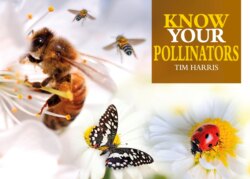Читать книгу Know Your Pollinators - Tim Harris - Страница 6
На сайте Литреса книга снята с продажи.
BEES AND WASPS
ОглавлениеBuff-tailed bumblebee (Bombus terrestris) covered with pollen.
Bees are pollinators par excellence. More than 20,000 different kinds are known. Most visit flowers to suck up energy-giving nectar. Pollen—essential for the raising of young—attaches to a bee’s body as it moves from plant to plant. Some are more efficient pollen collectors than others. For example, hairy bumblebees have pollen-gathering “brushes” on various parts of their bodies. In moving from plant to plant, bees transfer pollen from the stamen of one flower to the stigma of the next, enabling pollination. Most of the pollen is taken back to the colony or the nest burrow to feed young bees.
The range of bee lifestyles is truly bewildering. In social species such as honeybees, female “workers” perform most of a colony’s important functions. There is a clear differentiation between breeding queens, nonbreeding workers, and male drones. The workers make honey from nectar, pollen, and enzymes produced in their stomach, and this provides food during the winter, when nectar and pollen are unavailable.
Most bees are solitary, however, with a single female establishing a nest and laying eggs. And still more bees are kleptoparasites, breaking into the nests of other bees to lay their own eggs inside. Closely related, wasps are predatory insects but since they also visit flowers, they are pollinators too.
